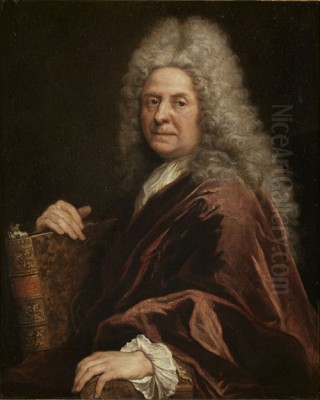
Antoine Coypel stands as a significant figure in the landscape of French art during the late 17th and early 18th centuries. Born into an era dominated by the grandeur of the Baroque, Coypel navigated the complex artistic currents of his time, establishing himself as a preeminent painter, etcher, and decorative designer. His career was marked by prestigious appointments, influential teaching, and the creation of works that adorned royal palaces and religious institutions. As the son of a renowned artist and the father of another, he was central to a veritable artistic dynasty that left an indelible mark on French cultural history.
Early Life and Formative Influences
Born in Paris on April 11, 1661, Antoine Coypel was immersed in the world of art from his earliest days. His father was the distinguished painter Noël Coypel, a respected artist and later the director of the French Academy in Rome. Under his father's tutelage, Antoine received his foundational training in drawing and painting, benefiting immensely from the guidance of an established master. This familial connection provided him with opportunities and insights that were crucial for his development.
A pivotal experience in his youth was the time spent in Rome. When Noël Coypel was appointed director of the French Academy there, Antoine accompanied him. This period, from approximately age 11 to 15, exposed the young artist directly to the masterpieces of Italian art. He absorbed the lessons of the High Renaissance masters like Raphael and Titian, studied the dramatic intensity of Caravaggio, and even drew inspiration from the elegance of earlier figures like Botticelli. The vibrant artistic environment of Rome, coupled with the structured learning at the Academy, profoundly shaped his artistic vision and technical skills.
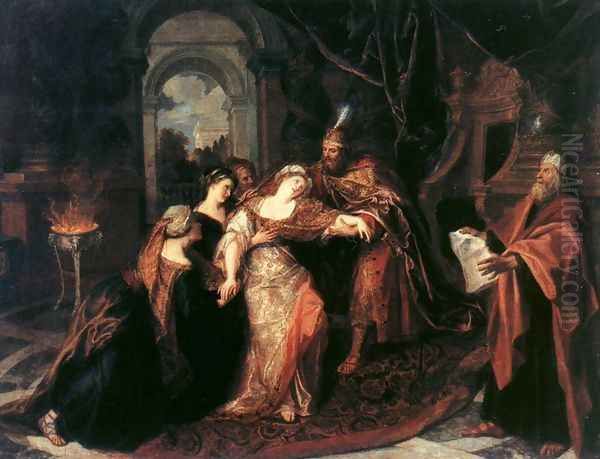
Beyond Italian influences, Coypel was also deeply engaged with the works of Flemish and French masters. The dynamism, rich colour, and emotional energy of Peter Paul Rubens made a lasting impression on him, becoming a recurring point of reference in his own compositions. Simultaneously, he studied the more restrained, classical compositions of Nicolas Poussin, the leading figure of French Classicism. Coypel's artistic journey would involve a continuous dialogue, and sometimes a tension, between these powerful, yet differing, artistic poles – the colouristic and dramatic versus the linear and classical.
Ascendancy in the Parisian Art World
Upon returning to Paris around 1680, Antoine Coypel quickly sought to establish his reputation. His talent, honed by his Roman studies and paternal instruction, was readily apparent. In 1681, at the young age of 20, he achieved a significant milestone by being accepted into the prestigious Académie Royale de Peinture et de Sculpture (Royal Academy of Painting and Sculpture). His reception piece, reportedly depicting Louis XIV Resting in Glory after the Peace of Nijmegen, showcased his abilities in the grand manner expected for historical subjects and allegories praising the monarch.
Membership in the Academy was crucial for any artist seeking major commissions and official recognition in France. Coypel's career within this institution steadily progressed. His skills as both an artist and potentially as a theorist and teacher were recognized by his peers. He became an active participant in the Academy's activities, contributing to its role as the central authority governing artistic taste and education in the kingdom.
His reputation grew throughout the 1680s and 1690s. He received commissions for decorative schemes, religious paintings, and mythological subjects, demonstrating versatility and a command of different genres. His ability to blend influences into a style that was both learned and visually appealing resonated with patrons and critics, solidifying his position as one of the leading painters of his generation in Paris.
The Coypel Style: Synthesis and Elegance
Antoine Coypel's artistic style is best characterized as a sophisticated variant of the French Baroque. He sought to synthesize the rich colours and dynamic compositions associated with Rubens and the Venetian school with the more structured, classical ideals championed by Poussin and the Roman school. This attempt to reconcile the "colourists" and the "draughtsmen" (the Poussinistes versus the Rubénistes) was a central debate within the French Academy during his time, and Coypel's work often embodies this dialogue.
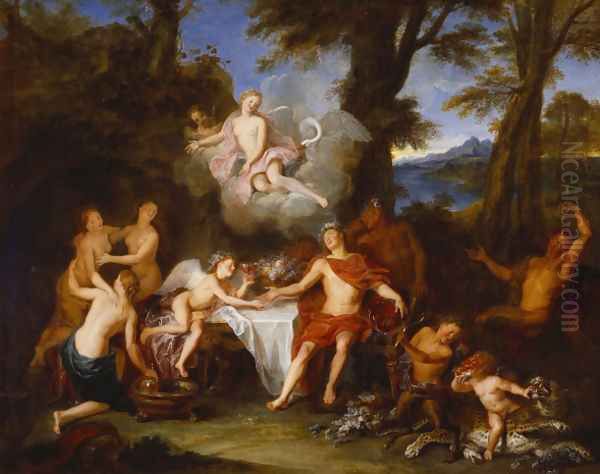
His paintings frequently feature complex allegorical or historical narratives, rendered with a sense of theatricality and grandeur. Figures are often depicted with expressive gestures and flowing drapery, contributing to the overall dynamism of the scene. He possessed what contemporaries described as an "elegant imagination," allowing him to imbue mythological and biblical scenes with a graceful, almost lyrical quality. This elegance sometimes foreshadowed the lighter sensibilities of the emerging Rococo style, although Coypel remained fundamentally rooted in the Baroque tradition.
However, his work was not without its critics, then or later. Some found his style occasionally prone to affectation or mannerism , a certain artificiality that perhaps reflected the highly refined, yet sometimes superficial, tastes of the courtly society he served. His elegant figures could sometimes feel idealized to the point of lacking robust naturalism. Despite these critiques, his ability to manage large-scale compositions, his skillful use of colour, and his inventive approach to traditional subjects secured his importance. He excelled particularly in history painting, biblical scenes, mythological narratives, and portraiture.
Major Commissions and Representative Works
Antoine Coypel's talent secured him numerous high-profile commissions throughout his career. One of his most significant undertakings was the decoration of the ceiling of the Royal Chapel at the Palace of Versailles. Although the source text mentions The Triumph of Love (La Triomphante de l'Amour) potentially for Versailles (perhaps a gallery ceiling dated 1706), his most famous work there is the large ceiling painting in the Royal Chapel, depicting God the Father in His Glory Promising the Coming of the Messiah, completed around 1708-1710. These large-scale decorative works allowed him to fully deploy his compositional skills and mastery of the Baroque idiom, creating immersive and awe-inspiring environments.
He also received important religious commissions. The source mentions an altarpiece for Notre Dame Cathedral in Paris, attesting to his status as a painter capable of undertaking significant works for the Church. While the specific subject isn't named in the provided text, such commissions were prestigious and demanded a high level of skill in depicting sacred narratives with appropriate dignity and emotional depth.
Several specific paintings are highlighted as representative of his oeuvre. Democritus (1692), noted for showing the influence of Rubens, likely refers to his painting Democritus Laughing. Another work mentioned alongside this in the source text is The Swooning of Esther (or Esther Fainting before Ahasuerus), demonstrating his engagement with Old Testament themes. The Alliance of Bacchus and Cupid points to his facility with mythological subjects, often imbued with allegorical meaning.
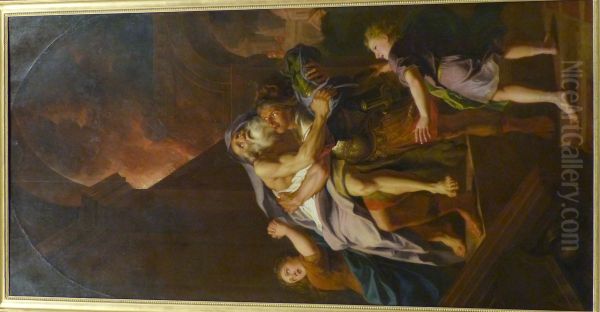
A later work, Aeneas Carrying Anchises (dated 1715-1717), now housed in the Musée Fabre in Montpellier, showcases his continued exploration of classical themes derived from Virgil's Aeneid, rendered with characteristic drama and movement. Furthermore, Coypel was also a skilled etcher. The etching Judith and Holofernes is cited as an example of his work in printmaking, where he often reproduced his own designs or created original compositions. He also collaborated with his son, Charles-Antoine Coypel, on designs for a series of large tapestries illustrating scenes from Cervantes' Don Quixote.
Academic Leadership and Royal Patronage
Antoine Coypel's career reached its zenith in the early 18th century, marked by significant academic and court appointments. His long service and high standing within the Académie Royale culminated in his appointment as Professor in 1707, where he played a direct role in shaping the next generation of artists. His influence grew further when he was named Director (Directeur) of the Academy in 1714, placing him at the very head of the official art establishment in France.
Beyond the Academy, Coypel enjoyed powerful patronage. He served as court painter to Philippe II, Duke of Orléans, who acted as Regent of France during the minority of Louis XV. This position provided him with consistent work and placed him close to the center of political and cultural power.
The ultimate recognition came in 1716 when he was appointed Premier Peintre du Roi (First Painter to the King). This was the highest artistic office in the kingdom, previously held by figures like Charles Le Brun. It signified the monarch's supreme confidence in his abilities and taste. The following year, in 1717, his status was further elevated when he was granted a title of nobility, a rare honor for an artist, reflecting his exceptional standing. These appointments cemented his legacy not only as a master painter but also as a figure of considerable influence in the cultural life of France.
The Coypel Dynasty and Artistic Legacy
Antoine Coypel was a central figure in what can be considered an artistic dynasty. His father, Noël Coypel (1628-1707), was not only his first teacher but also a highly successful painter and academician in his own right, known for his classical style and major decorative commissions, including work at Versailles and as Director of the French Academy in Rome. Noël's influence on Antoine's early development was profound.
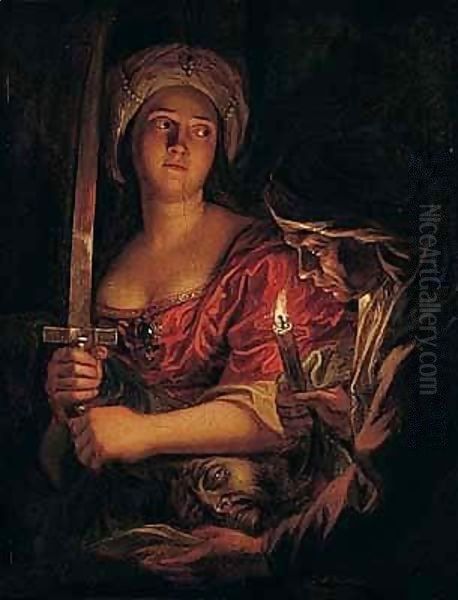
Antoine, in turn, passed on the artistic mantle to his own son, Charles-Antoine Coypel (1694-1752). Charles-Antoine followed closely in his father's footsteps, becoming a successful painter, particularly known for his historical subjects and portraits, as well as theatrical designs. He collaborated with his father, notably on the Don Quixote tapestry cartoons, and eventually succeeded him in prestigious roles, becoming First Painter to the King and Director of the Academy himself. This direct succession highlights the strong familial bonds and transmission of artistic knowledge within the Coypel family.
Antoine also had a younger half-brother, Noël-Nicolas Coypel (1690-1734), who also became a respected painter and professor at the Academy. While Noël-Nicolas developed his own distinct style, often leaning more towards the emerging Rococo aesthetic with its lighter palette and mythological subjects focused on grace and charm, his career further underscores the family's deep involvement in the Parisian art world. The Coypels, across three generations, represent a significant lineage within French painting.
Teaching, Collaboration, and Contemporaries
Beyond his own prolific output and his family connections, Antoine Coypel exerted influence through his role as a teacher at the Academy. He guided numerous students, imparting the principles of composition, drawing, and painting according to the academic doctrines of the time, blended with his own stylistic preferences. One documented student mentioned in the source material is Jean-Antoine Riquier, who went on to have his own career, benefiting from Coypel's instruction.
Coypel also engaged in collaborations with fellow artists. The source notes his work with Jean-Baptiste van Loo (likely referring to a member of the prominent Van Loo family of painters active in France), suggesting a professional interaction and mutual respect among peers working on large-scale projects or specific commissions. Such collaborations were not uncommon, particularly for extensive decorative schemes.
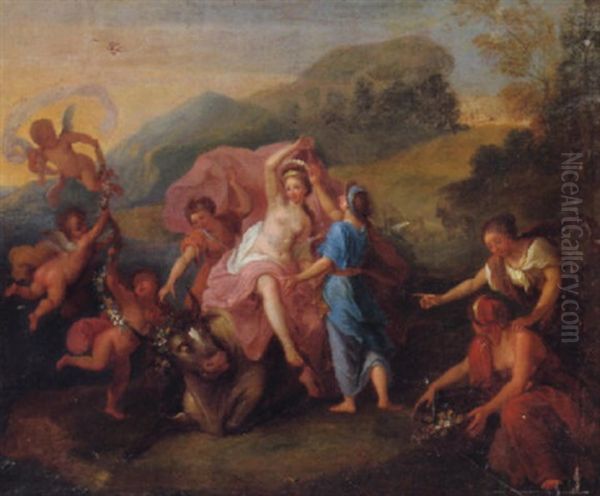
Antoine Coypel worked during a vibrant period in French art, bridging the High Baroque of Louis XIV's reign with the emerging Rococo style of the Régence and Louis XV's early reign. His contemporaries included artists working in diverse styles. While he maintained a Baroque grandeur influenced by Poussin and Rubens, figures like Jean-Antoine Watteau (1684-1721) were pioneering the fête galante, characterized by its depictions of elegant outdoor gatherings and theatrical charm. Other contemporaries included Jean-François de Troy (1679-1752) and François Boucher (1703-1770), both masters of the Rococo style, known for their sensuous mythological scenes, decorative flair, and lighter palettes, offering a contrast to Coypel's more formal history painting. Yet, Coypel also worked alongside other history painters upholding the grand tradition, such as Jean-Baptiste Jouvenet (1644-1717), another prominent member of the Academy known for his large religious and historical canvases. The artistic landscape was rich and varied, with Coypel occupying a central, respected position within it. His influences, including Italian masters like Raphael, Caravaggio, Titian, and Botticelli, further place his work within a broad European context.
Later Reputation and Enduring Significance
Despite the immense success and recognition Antoine Coypel enjoyed during his lifetime, his critical reputation experienced fluctuations after his death on January 7, 1722. As artistic tastes shifted decisively towards the Rococo and later towards Neoclassicism in the mid-to-late 18th century, Coypel's style, rooted in the Baroque synthesis, began to seem less fashionable. His work, sometimes perceived as overly theatrical or lacking the lightness of the Rococo or the stern simplicity of Neoclassicism, was gradually somewhat underestimated, as noted in the source material.
However, a more balanced historical perspective recognizes Antoine Coypel's crucial role in the evolution of French art. He stands as one of the most important painters working in France between the era of Charles Le Brun and the full flowering of the Rococo. His attempt to synthesize the influences of Rubens and Poussin, colour and line, drama and classicism, represents a key moment in French academic art theory and practice. His large-scale decorations, particularly at Versailles, remain significant examples of French Baroque decorative painting.
His influence extended through his numerous students and his leadership at the Academy. As First Painter to the King and Director of the Academy, he helped shape the institutional framework of art in France. His prolific output across various genres – history, mythology, religion, portraiture, and printmaking – demonstrates his versatility and mastery. Antoine Coypel remains an essential figure for understanding the complexities and grandeur of French art at the turn of the 18th century, a bridge between traditions and a master in his own right.